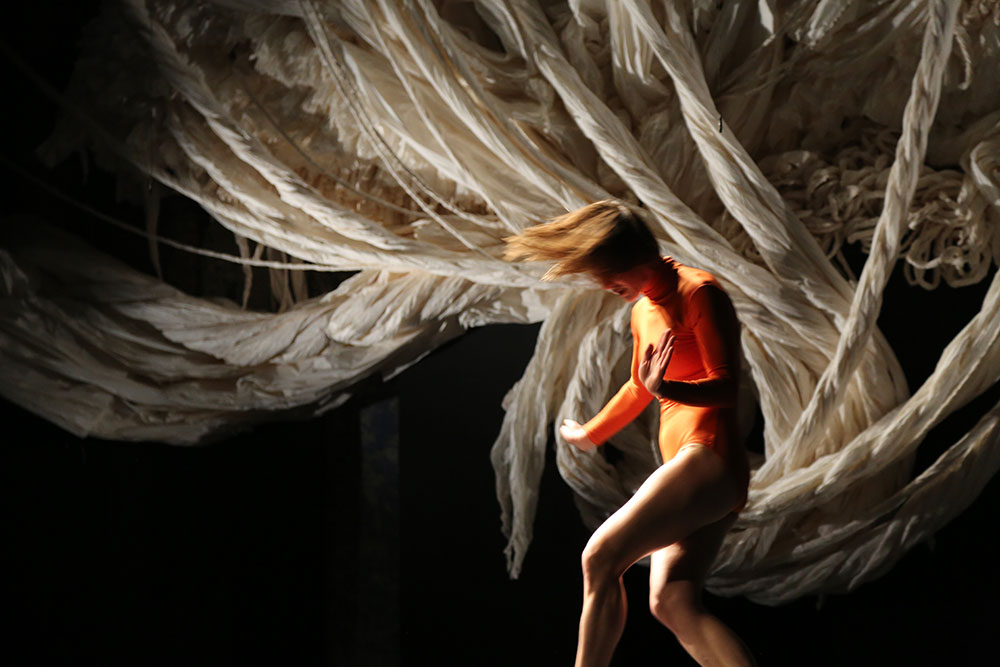Death And Grief Share Center Stage In Keen [No. 2]
Elizabeth Zimmer, Village Voice
Elizabeth Zimmer, Village Voice
“Death is serious,” the poet Howard Nemerov once wrote, “or else all things are serious except death. A player who dies automatically disqualifies for the finals.”
Contemplating Ivy Baldwin’s very serious Keen [No. 2], I find myself observing how difficult it is to make powerful art while in the throes of mourning. Grieving in American culture is often intensely private; art, on the other hand, requires giving emotion a public character. Baldwin, a longtime light on the downtown dance scene, has since 2015 been racked and paralyzed with sadness over the too-quick, too-early death of her star player, Lawrence P. Cassella, who succumbed at thirty-eight to HLH, a rare autoimmune illness.
Last year Baldwin made a stab at dealing with her pain in a site-specific quartet, Keen (Part 1), at Philip Johnson’s Glass House in Connecticut. This month she expands the piece at the old Playhouse Theater at the Henry Street Settlement, its small proscenium stage backed with a stunning white-paper construction (by Wade Kavanaugh and Stephen B. Nguyen), all puffs and swirls and tightly rolled tails, a tableau that calls to mind an exploded version of Michelle Obama’s 2009 inaugural gown.
The form of the work alternates solos (by Katie Workum, Eleanor Smith, and Baldwin) and one powerful duet (for Smith and Workum, the only moment when the women let themselves touch, support, and embrace each other) with group sections in which all ten float and crawl and lie along the stage, occasionally flocking into unison. Parts of Keen are improvised, developed by and with the dancers, which results in a structural looseness.

Watching the ensemble dash around in flowing, chiffon-like orange caftan-capes, one imagines the Wilis of Giselle somehow mated with fire, but lacking the tight focus with which that ballet’s fierce women, themselves dead, exact revenge on the living Prince Albrecht. Baldwin’s situation is precisely the opposite: Her prince is dead and her acolytes flutter aimlessly, rarely connecting with one another or with anything at all. (Baldwin assays a long solo early in the piece, turning slowly in an arabesque; on opening night, after a while, a member of the audience began applauding, a response that might have been sarcastic given the downtown community’s rejection of such balletic poses.)
Justin Jones’s recorded score, a diverse collage of drone-like industrial sounds and occasional chords for strings, is interspersed with live keening (the Gaelic-descended term, indicating a vocal lament, for which the piece is named) by the performers. Sometimes they utter quiet but piercing screams; sometimes they caw or crow like the birds they resemble. Possibly because of the scarcity of physical contact among them, they come to seem other than human — animals or angels by turns. They descend and run through the audience, creating a pleasant breeze as they return to the stage; the boundary between platform and house becomes an edge beyond which loss is still strong. Smith stands alone, gathering some invisible force into her center, kicking her legs toward the house.
A co-production of Abrons Arts Center, the Chocolate Factory Theater, and the Joyce Theater (part of Joyce Unleashed, its commitment to supporting experimental work in smaller spaces), Baldwin’s piece explores emptiness. It goes on for close to eighty minutes, a long time for observers to sit with it. We get impatient with grief, want our friends, relatives, even ourselves to snap out of it; most of us haven’t the resources, the depth of feeling, or the tenacity to create or witness a ceremony like this. Just when our seated bodies begin to rebel, the sound of tearing fills the theater, and the orange-clad women, one of them several months pregnant, race down the aisles trailing fistfuls of white paper, the same material so artfully deployed on the back wall. They beat the floor and that wall with their burden; a couple tear off parts of the shapely arrangement of tails in the backdrop. The sound grows louder as the lights fade. Clearly Baldwin is not finished mourning.
Elizabeth Zimmer for The Village Voice –
June 7, 2017.





























